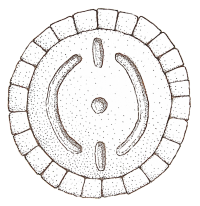The Valdres
The Valdres is a forest, but this word is insufficient. It is a kingdom unto itself: it has its own customs and laws, its own gods, and it defends its borders.
It stretches east as far as the Dawn Mountains, a sea of beeches, maples, and the ancient oaks. The mightiest of these are the ghostwoods, which, it is said, never shed their leaves, except in the long night of an Age of Sorrow. Dark things move beneath the canopy, and the leaves whisper endlessly. Beneath the tangled roots, the moss and fallen leaves, there are ruins in the Valdres; villages, tombs, and shrines abandoned to the forest, and the things which live there.
In the north, past the Holy Mountain, the forest turns to pine. Unlike the south, this region has never seen human settlement. It remains perfectly desolate and untracked; the rare travelers through this area prefer the bleakness of the Rustlands to the northern forest.
To the merchants of the Empire and the explorers of the western kingdoms, the Valdres is as impassable as the towering Dragonmounts--the edge of the world.
As the old stones and swallowed villages tell, it was not always thus.
History
Ancient Tormar
The Tormen have lived and worshiped at the edge of the Valdres for millenia; their legends stretch back into the darkness of prehistory. Certainly they predate the coming of the Marchmen in the Age of Glory, and before this time, only their own legends exist as a record.
The oldest sagas tell that they were first men to walk the earth, freed from ice by the sun god Shaulk. They tell of the deeds and the tragedies of kings and champions, the wars of the ancient clans, and of the people's struggles with the western giants and the wood-elves, and other, stranger creatures of the Valdres.
They trod paths through the Valdres, sunken, mossy roads which flood in fall and freeze in winter. They hunted elk, ironboar and the lumbering visent with spears of ghostwood. Theirs was the Kingdom of Tormar, though the kingdom was more often contested or divided between the chiefs than it was united under a strong king.
Each petty chief held his own little stronghold, but the kings kept no permanent fortress or capitol. The only constant was the Necropolis of Hansalk, the burial site of the ancient kings and the great legendary heroes. Here, amidst the great stones and the ghostwoods, the court assembled each spring to seek the counsel of the ancestors, the forest spirits, and the gods.
They taught the Marchmen the words and rites to appease the High Gods, but theirs was also a pantheon of innumerable minor local deities, nature spirits, and legendary ancestors. They filled the forest with shrines to the spirits, and tombs for the honored dead, and they raised stones to ward off those things that would not be appeased. In that age before the coming of the Marchmen, they built the Poliad, a great carven temple, on the slopes of the Holy Mountain, which rose above the western edge of the forest.
The Fall
The War of the Torch brought about the end of Tormar. The Black Kings brought fire and dark magic, fighting the forest and the Tormen at once. The forest won, and men of both kingdoms lost, but the Tormen most of all. The wood crept over boundary stones broken by the invaders, choking towns and villages already injured by the war. Cleared land, farmed for centuries, was consumed in days. Whatever pacts the ancient Tormen had struck were gone now, and both sides were driven from the wood. Those that could not flee, or who could not flee fast enough, were never seen again.
The Poliad was swallowed, the sacred mountain made an island as the green tide rolled west. The Ballad of Orin tells the story of the last king of Tormar, consumed along with the Necropolis, entombed alongside his ancestors.
Tormen still live in a few towns and villages to the south of the wood, settlements huddled around their ancient hillforts. No roads connect their plain with the west, though southern ships sometimes find their way to the mouth of the Greenwater. Though they may meet Tormen here, they do not find Tormar; it is three centuries dead, and buried within the Valdres.

No Comments